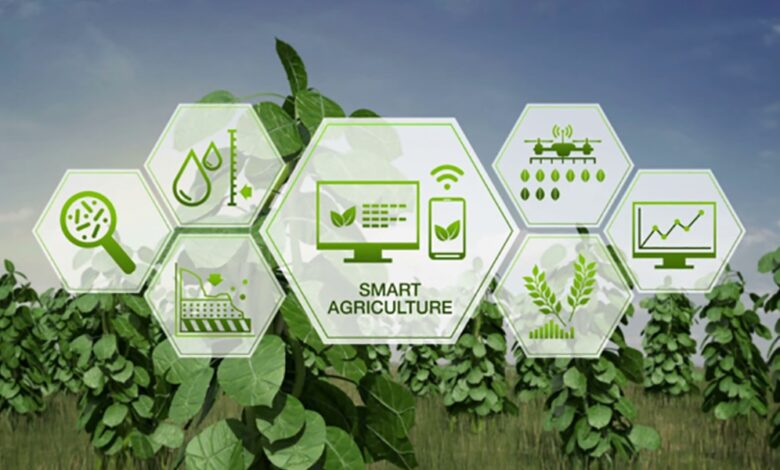
IoT in agriculture is transforming traditional farming into a data-driven, technology-powered industry. The integration of IoT devices in farming practices has revolutionized crop management, livestock monitoring, and resource optimization, making agriculture more efficient and sustainable. From precision irrigation systems to smart sensors that track soil health, IoT in agriculture is paving the way for smart farming solutions that maximize yields while minimizing environmental impact.
As the global demand for food continues to grow, IoT in agri sector addresses challenges such as water scarcity, labor shortages, and unpredictable climate conditions. By leveraging real-time data and automation, farmers can make informed decisions that enhance productivity and sustainability. This article explores the various ways IoT in agri sector is shaping the future of farming, highlighting its benefits, applications, and impact on global food security.
Read More: IoT in Agriculture
The Role of IoT in Precision Agriculture
IoT in agriculture is driving precision agriculture by enabling targeted interventions and efficient use of resources.
Smart sensors and GPS-enabled devices monitor variables like soil moisture, temperature, and nutrient levels. This data guides precise applications of water, fertilizers, and pesticides, ensuring optimal growth conditions and reducing waste.
Smart Irrigation Systems Enhancing Water Efficiency
IoT in agriculture is revolutionizing irrigation by providing systems that optimize water usage for better efficiency and crop health.
IoT-enabled irrigation systems use real-time data from soil moisture sensors to deliver water exactly when and where it is needed. These systems reduce water waste, lower costs, and ensure sustainable water management practices.
IoT for Livestock Monitoring and Management
Livestock management benefits greatly from IoT in agriculture, ensuring animal health and productivity.
Wearable devices monitor vital signs, activity levels, and feeding patterns of livestock. These insights enable farmers to detect health issues early and optimize breeding and feeding schedules, improving animal welfare and operational efficiency.
Smart Greenhouses Powered by IoT
IoT in agriculture has made smart greenhouses a reality, allowing for controlled and automated environments for crop growth.
Connected sensors regulate temperature, humidity, and light intensity based on plant requirements. These systems enhance productivity, reduce energy consumption, and ensure high-quality produce, regardless of external weather conditions.
Predictive Analytics in Farming
IoT in agriculture leverages predictive analytics to forecast trends, helping farmers make proactive decisions.
Data collected from IoT devices is analyzed to predict pest outbreaks, weather changes, and optimal harvest times. These insights empower farmers to mitigate risks and plan operations effectively, ensuring better yields and profitability.
Autonomous Farming Equipment
IoT in agriculture is driving the adoption of autonomous machinery, reducing labor dependency and enhancing efficiency.
Self-driving tractors, drones, and robotic harvesters use IoT connectivity to perform tasks like plowing, planting, and harvesting. These technologies save time, reduce costs, and improve precision in farming operations.
IoT for Pest and Disease Management
IoT in agriculture plays a critical role in pest and disease management, reducing crop losses and improving productivity.
IoT sensors and cameras detect early signs of infestations or diseases. Real-time alerts enable farmers to take timely action, minimizing damage and reducing the need for chemical interventions.
Soil Health Monitoring with IoT
IoT in agriculture enhances soil health management, ensuring optimal growing conditions for crops.
Soil sensors measure parameters like pH, moisture, and nutrient content. This data allows farmers to tailor soil treatments, improving fertility and ensuring sustainable land management practices.
Supply Chain Optimization in Agriculture
IoT in agriculture extends to supply chain management, ensuring efficiency from farm to table.
Connected devices track the storage and transportation conditions of produce, ensuring quality and reducing waste. IoT-powered supply chains provide transparency, enabling consumers to trace the origin of their food.
IoT in Aquaculture
IoT in agriculture includes applications in aquaculture, improving fish farming practices.
Sensors monitor water quality, temperature, and oxygen levels in fish tanks. These systems optimize feeding schedules and maintain ideal conditions, increasing yield and ensuring the health of aquatic species.
Weather Monitoring Systems for Farmers
IoT in agriculture utilizes weather monitoring systems to provide farmers with real-time updates and forecasts.
Weather stations equipped with IoT devices collect data on temperature, humidity, wind, and rainfall. These insights help farmers plan activities like planting, irrigation, and harvesting, reducing risks associated with unpredictable weather.
Blockchain Integration with IoT in Agriculture
IoT in agriculture integrates with blockchain to enhance traceability and transparency in farming operations.
Blockchain records data collected by IoT devices, ensuring secure and tamper-proof information on farming practices. This integration builds trust among consumers and stakeholders while supporting sustainable practices.
IoT in Agroforestry
Agroforestry benefits from IoT in agriculture by optimizing land use and enhancing biodiversity.
IoT devices monitor soil and environmental conditions to ensure the compatibility of crops and trees. These systems promote sustainable farming methods that balance agricultural productivity with ecological preservation.
Energy Efficiency in Agriculture with IoT
IoT in agriculture improves energy efficiency, reducing costs and environmental impact.
Smart devices manage energy usage in operations like irrigation, greenhouse management, and machinery operation. These systems optimize resource use, supporting sustainable farming practices.
IoT for Farm Worker Safety
IoT in agriculture ensures the safety and well-being of farm workers through wearable devices and monitoring systems.
Wearable sensors track health metrics and environmental conditions, alerting workers and managers to potential hazards. These technologies enhance safety protocols and reduce workplace injuries.
IoT in Vertical Farming
IoT in agriculture enables vertical farming, a solution to urban food production challenges.
Connected sensors and automation control lighting, temperature, and nutrient delivery in multi-layered farms. These systems maximize productivity in limited spaces, reducing the environmental footprint of food production.
IoT in Agricultural Research and Development
IoT in agriculture supports research and development, driving innovation in farming practices.
Real-time data collection from IoT devices provides researchers with valuable insights into crop performance, pest behavior, and climate impact. These findings contribute to the development of advanced agricultural solutions.
IoT for Smallholder Farmers
IoT in agriculture empowers smallholder farmers, improving their access to technology and information.
Affordable IoT devices provide data on weather, soil health, and market trends. These tools enable small-scale farmers to enhance productivity and compete in the global market.
IoT in Crop Insurance
IoT in agriculture plays a vital role in crop insurance, providing accurate data for risk assessment and claims processing.
Sensors monitor weather conditions, pest activity, and crop health, ensuring fair and efficient insurance practices. These technologies protect farmers from financial losses and encourage sustainable farming.
Future Trends in IoT in Agriculture
The future of IoT in agriculture promises greater connectivity, automation, and sustainability in farming practices.
Emerging technologies like AI-powered IoT devices, advanced robotics, and 5G connectivity will enhance the efficiency and precision of smart farming. These innovations will address global food security challenges, ensuring a sustainable future for agriculture.
Read More: IoT in Agriculture
Conclusion
IoT in agriculture is transforming farming by introducing precision tools, real-time monitoring, and automation. These advancements enhance productivity, reduce waste, and promote sustainability, ensuring the agricultural sector can meet global food demands. From smart irrigation systems and livestock monitoring to blockchain-integrated supply chains, IoT is creating smarter, more efficient farming ecosystems.
As technology continues to evolve, the potential of IoT in agriculture will expand, offering innovative solutions to complex challenges. By embracing these technologies, farmers can optimize operations, protect the environment, and secure the future of food production for generations to come.
FAQs
1. How is IoT transforming agriculture?
IoT enables real-time data collection, precision farming, and automation, improving productivity and sustainability in agriculture.
2. What are the benefits of IoT in agriculture?
IoT enhances resource efficiency, reduces waste, improves crop yields, and ensures better decision-making for farmers.
3. How does IoT support sustainable farming?
IoT optimizes water, energy, and fertilizer use while promoting eco-friendly practices and reducing environmental impact.
4. What role does IoT play in livestock management?
IoT devices monitor livestock health, feeding, and activity, ensuring animal welfare and operational efficiency.
5. What are future trends in IoT in agriculture?
Future trends include AI integration, advanced robotics, and 5G connectivity, driving smarter and more efficient farming solutions.











